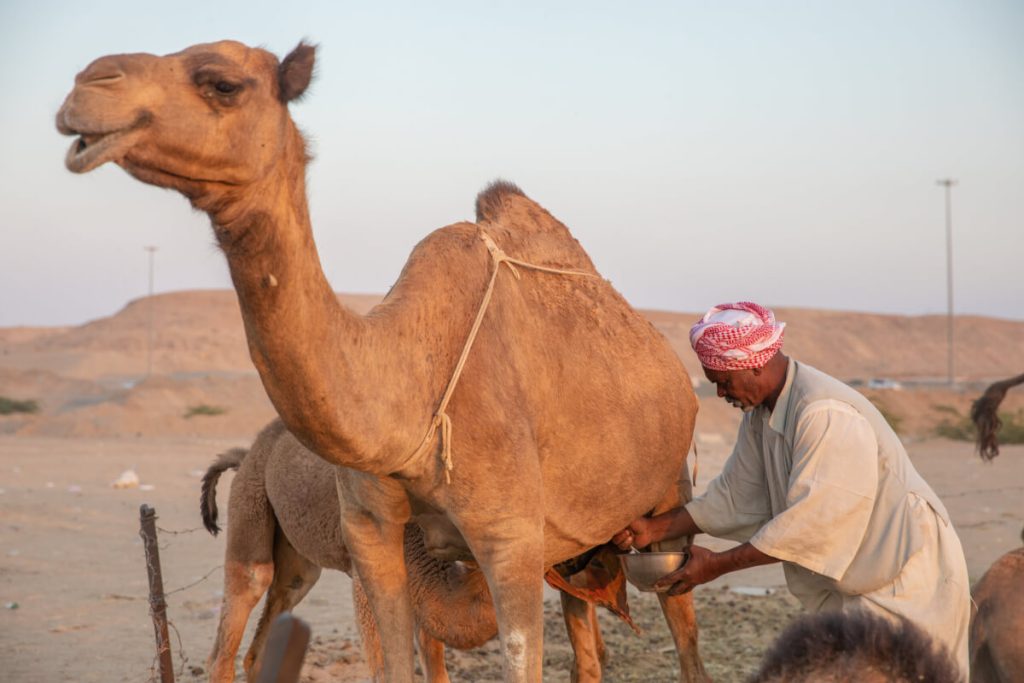

Camel milk may be better for our immune health than cow’s milk. (Leo Morgan/Shutterstock)
In a nutshell
- Camel milk contains significantly more immune-supporting proteins than cow’s milk (1,143 vs. 851) and lacks the main protein that triggers dairy allergies
- Its bioactive compounds may help fight harmful bacteria, support heart health, and create a healthier gut environment, though more research is needed
- While production is currently limited (camels produce about 5L/day vs. cows’ 28L), camel milk’s ability to be produced in arid climates makes it promising for regions where traditional dairy farming is challenging
JOONDALUP, Australia — Move over almond milk. There’s a new dairy alternative in town, and it comes from camels. While that might sound strange to Western ears, new research from Edith Cowan University (ECU) in Australia suggests camel milk could offer some impressive health benefits, especially for our immune systems.
The study, published in Food Chemistry, explored an in-depth analysis comparing cow and camel milk, focusing particularly on proteins that affect immune function and digestion. While cow’s milk dominates global dairy production at over 81%, camel’s milk currently accounts for just 0.4% of global milk production. Unlike cow’s milk, it contains distinctive proteins that could make it especially valuable for immune system support and gut health.
When examining the cream portion of both milk types, scientists identified 1,143 proteins in camel milk compared to 851 in cow’s milk. The cream fraction proved particularly rich in immune system-supporting proteins and bioactive peptides that can help fight harmful bacteria and potentially protect against certain diseases. However, researchers emphasize that further testing is needed to confirm their potency.
“These bioactive peptides can selectively inhibit certain pathogens, and by doing so, create a healthy gut environment and also has the potential to decrease the risk of developing cardiovascular disease in future,” explains study researcher Manujaya Jayamanna Mohittige, a Ph.D. student at ECU, in a statement.


For people who struggle with dairy sensitivities, the study confirms that camel milk naturally lacks beta-lactoglobulin, the primary protein that triggers allergic reactions to cow’s milk. Additionally, camel milk contains lower lactose levels than cow’s milk, potentially making it easier to digest for some individuals.
Composition-wise, camel milk is slightly different from cow’s milk. Cow’s milk typically contains 85-87% water, with 3.8-5.5% fat, 2.9-3.5% protein, and 4.6% lactose. Camel milk, meanwhile, consists of 87-90% water, with protein content varying from 2.15-4.90%, fat ranging from 1.2-4.5%, and lactose levels between 3.5-4.5%.
Camel milk production currently ranks fifth globally behind cow, buffalo, goat, and sheep milk. Given Australia‘s semi-arid climate and camel population, increasing its production is an increasingly viable option.
“Camel milk is gaining global attention, in part because of environmental conditions. Arid or semi-arid areas can be challenging for traditional cattle farming, but perfect for camels,” adds Mohittige.
However, there are practical challenges to overcome. While dairy cows can produce up to 28 liters of milk daily, camels typically yield only about 5 liters. Several camel dairies already operate in Australia, but their production volumes remain relatively low.


This doesn’t mean everyone should rush out and switch to camel milk. It’s still relatively hard to find in many places and typically costs more than cow’s milk. But for people looking for alternatives to traditional dairy, especially those with certain milk sensitivities, camel milk might offer an interesting option.
While camel milk may not appear in your local supermarket just yet, this research reveals why it deserves attention beyond its novelty value. Its unique protein profile and immune-supporting properties may help explain why this unconventional dairy source has persisted for millennia in cultures worldwide.
Paper Summary
Methodology Explained
Researchers used a sophisticated approach to analyze milk samples from both species, separating them into different fractions (cream, skimmed, and whole milk) and treating them with various chemical processes to identify and quantify proteins. They employed state-of-the-art mass spectrometry techniques to identify individual proteins and peptides and used multiple extraction methods to ensure a comprehensive analysis of bioactive compounds. Two approaches, straightforward filtration and protein precipitation, proved highly effective at identifying beneficial peptides, while a third method using solvents was less successful.
Key Results
The study found significantly more proteins in camel milk (1,143) compared to cow’s milk (851), with the cream fraction showing the highest concentration of immune-related proteins in both species. Camel milk showed superior potential for generating bioactive peptides and lacked the main allergen found in cow’s milk, while maintaining a similar overall protein profile.
Study Limitations
The research used commercially pooled milk samples rather than milk from individual animals, which might not capture all possible variations. Additionally, the study focused on protein analysis and didn’t investigate the actual biological activity of these proteins in human subjects.
Discussion and Takeaways
The findings suggest that camel milk could be a valuable alternative to cow’s milk, particularly for people with certain dairy sensitivities. The higher concentration of immune-supportive proteins and bioactive peptides indicates potential health benefits that warrant further investigation.
Funding and Disclosures
This research was supported by the Australia Research Council Centre of Excellence for Innovations in Peptide and Protein Science.
Publication Information
Published in Food Chemistry (Volume 467, 2025), this study was conducted by researchers from Edith Cowan University, the Australian Research Council Centre of Excellence for Innovations in Peptide and Protein Science, the University of Sydney, and the Commonwealth Scientific and Industrial Research Organisation.








